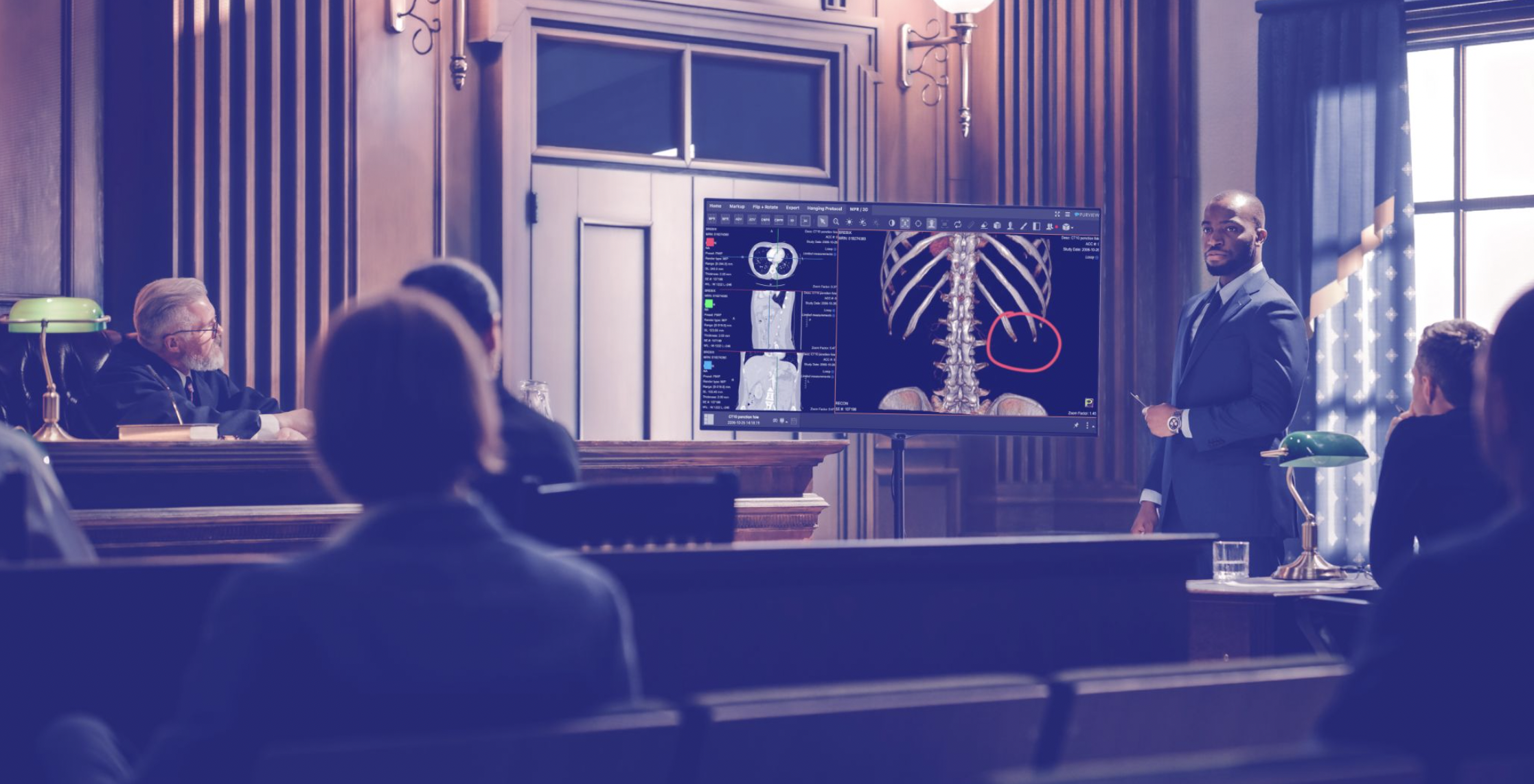The Visual Verdict: DICOM vs. JPG Images in Legal Proceedings

When an attorney is deciding between easy-to-handle JPG images or larger and bulkier DICOM files to illustrate their clients’ medical issues, which is better? Should you take the easy way out?
What you may not know is that the file format for these images can significantly differ, impacting their integrity and relevancy to your case. If winning your case is important to you or your client, you probably shouldn't take the easy way out.
What's the Difference?
Before diving into the reasons why DICOM is preferable, let's briefly review the differences between DICOM and JPG:
- DICOM (Digital Imaging and Communications in Medicine) is a specialized format specifically designed for medical imaging. It stores not only the image itself but also important metadata such as patient information, acquisition parameters, and more. DICOM files are used extensively in healthcare settings and are the standard for storing, viewing and transmitting medical images like X-rays, MRIs, CT scans, and ultrasounds. Different than a simple two-dimensional picture, DICOM scans may depict three dimensions or may be time based. Viewing and storing DICOM requires special purpose software.
- JPG (or JPEG), in contrast, is a more generic image format used widely across various industries. It compresses images to reduce file size, making it convenient for sharing and displaying images both in print and on the web. However, this compression can lead to loss of image data, potentially affecting the quality and accuracy of the image.
Accuracy and Integrity of Medical Images
In legal cases involving medical issues, accuracy is critical. DICOM files retain the original quality of medical images without any loss of information that might be introduced by compression. This means that every pixel of the image is preserved, ensuring that lawyers, medical experts, judges and juries see the image exactly as it was captured from the scanner. This level of fidelity is critical when analyzing subtle details in medical images.
When using JPG files, the compression algorithms can compromise image quality. Fine details may be lost or altered, potentially leading to misinterpretations or inaccuracies. In a legal context, this could have serious implications, as an inaccurate representation of medical evidence could weaken a case or lead to misunderstandings.
Comprehensive Metadata
DICOM files also contain a wealth of metadata that can be invaluable in legal proceedings. This metadata includes patient information, such as name, age, and medical record number, as well as details about the imaging procedure, such as the date and time of the study, imaging modality used, as well as other relevant information.
For lawyers, having access to this metadata can help establish a clear chain of custody for the images, verify their authenticity, and provide crucial context for medical experts and the court. It adds an extra layer of credibility and transparency to the evidence presented. While courts are often very flexible (or perhaps don’t understand DICOM) in their adherence to the best evidence rule, JPG files may not actually satisfy that requirement if the original DICOM is available.
Security and Compliance
Whether it's DICOM or JPG that you use, each requires compliance with HIPAA and data privacy. As an attorney dealing with Private Health Information (PHI) you must ensure that these image files remain secure and private. All medical images contain PHI! That means that you can’t trust their storage to a regular cloud-based file system like Google, Dropbox or Box.net.
While it may be enticing to attach a JPG file to a standard email, don’t! You can’t transmit these image files, containing PHI, no matter the format, unless that transmission is secure. You also can’t use them with cloud-based software, like your case management system unless it too is secure and HIPAA compliant. In each case, it is not sufficient that your vendor claims “HIPAA compliance.” You must also have each vendor sign a current Business Associate Agreement (BAA) indicating their agreement that their systems and processes are and will remain compliant with HIPAA and HITECH standards.
By the way, being HIPAA compliant means your firm must institute standard HIPAA procedures including regular training of your staff.
Enhanced Collaboration and Analysis
If your medical expert does not insist on you providing them with DICOM formatted images, you may want to rethink who you are engaging as an expert. While JPG files may indeed have some substantive value when reviewing a medical condition, DICOM files generally show a much richer and more detailed view of the actual medical scan.
DICOM files are designed for interoperability, meaning they can be easily shared and viewed across different systems and software used in healthcare settings. This is beneficial for lawyers working with medical experts, as they can easily collaborate on reviewing and analyzing images without compatibility issues.
Additionally, DICOM images can be viewed in specialized medical imaging software that offers advanced tools for measurements, annotations, multi-planar review and 3D reconstructions. This allows for in-depth analysis and even real-time collaboration when analyzing medical images, aiding lawyers and experts in understanding and communicating complex anatomical structures and pathologies.
Conclusion
While JPG may be suitable for everyday image sharing (like a photo of what you ate for dinner last night), it falls short when it comes to the rigorous demands of legal cases involving medical imaging. DICOM stands out as the superior choice for lawyers due to its unparalleled accuracy, comprehensive metadata, security features, and interoperability.
By opting for DICOM over JPG, lawyers can ensure that the medical evidence presented in court is of the highest quality, integrity, and compliance with privacy regulations. This not only strengthens their cases but also upholds the standards of accuracy and fairness in the legal system, ultimately serving the interests of justice and the well-being of those involved.
In the world of legal proceedings, where every detail matters, choosing the right file format for medical imaging can make all the difference. For lawyers seeking the best possible outcomes for their medical injury cases, DICOM is the clear and obvious choice.
For more about handling medical records during litigation, watch the webinar:
The Fast and Secure Way to Share Medical Records to Win Your Case
or reach out to us with your questions



